The two Schubert families
Posted by Richard on UTC 2020-07-08 14:24
There are already two detailed looks at the family of Franz Theodor Schubert on this website: one was focused on the children in the Schubert family, the other on the wider circumstances of the family.
These treatments left more or less untouched the doings of Franz Theodor's elder brother Karl. In fact, the destinies of the two brothers intertwined closely in Leopoldstadt for about six years.
Karl Schubert arrived at Andreas Becker's school there in 1775. Only three years later he married Becker's widow Anna. This event was not the foundation of a family, however, since the couple never had children. Their marriage would last fourteen years until Anna's death in 1792.
In 1778, the same year that his brother married, Franz Theodor moved from Moravia to his brother's school in Leopoldstadt. For around five years the school in Leopoldstadt was the centre of his life, too.
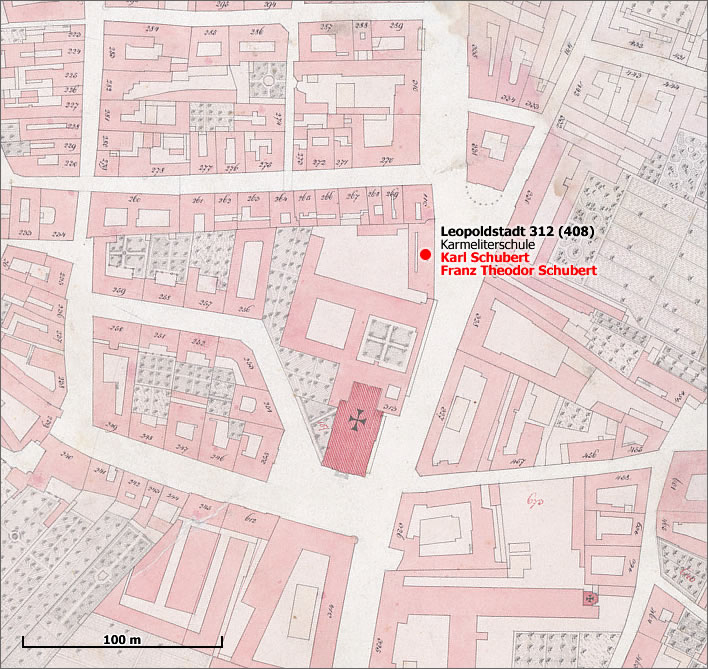
Karl Schubert's school in Leopoldstadt. Image: Stadtplan, Anton Behsel (1820-1825), Leopoldstadt 1822. ©ViennaGIS/FoS.
At some point he met Elisabeth Vietz and the pair moved to Lichtental in 1784. They married in the following year and Franz Theodor was able to open his own school the year after that.
Discounting Franz Ignaz, the out-of-wedlock baby who came and went, in the first seven years of that marriage seven babies arrived and left again, leaving only Ignaz in the family. That period of reproductive uproar contrasts sharply with the silence of absent children in the marriage of Karl and Anna.
In those seven years, whilst his brother and Elisabeth Vietz were producing babies, Karl was with his wife Anna, twice his age and well past baby production. Nevertheless, a baby came and went again in 1787. Karl was the father but the mother was not Anna but Magdalena Vietz, Elisabeth's sister.
The child does not seem to have been the result of a fling, since five years later, less than three months after Anna died, Karl and Magdalena married. It is from this point, 1792, that we can speak of the two parallel Schubert families of two brothers and two sisters, since both families were now producing babies.
After Karl's death at the end of 1804, the two families were merged in Himmelpfortgrund, when Karl's widow Magdalena and their only surviving daughter, Magdalena, became members of Franz Theodor's family. As we shall see later, the widowed sister-in-law and her daughter became not just members but important members of Franz Theodor's family.
Here is a table illustrating some events in the period beginning with Franz Theodor's move from Leopoldstadt to Lichtental and ending with Karl Schubert's death in 1804 at 49 years old.
| Year | Karl's family | Franz Theodor's family |
| 1784 | — | 08.08 Franz Theodor moves from Leopldstadt 408 to Zum goldenen Ring in Lichtental 152. Elisabeth follows him about a month later. |
| 1785 | — | 17.01 Franz Theodor and Elisabeth marry. 08.03 Ignaz Franz born (†1844, 59). |
| 1786 | — | 01.03 Elisabeth born 13.06 Franz Theodor gains a position as school teacher in Himmelpfortgrund 72 (Zum roten Krebsen). Family moves in. |
| 1787 | 02.10 Franz Vietz born to Maria Magdalena and Karl Schubert (dies 19.10 in the orphanage). | 23.04 Karl born 06.12 Carl Schubert, the brothers' father, dies in Neudorf. Legacy of 96 fl. each to the brothers. |
| 1788 | — | 06.02 Karl dies (9m). 06.06 Franziska Magdalena (1) born, dies 14.08 (2m). 13.08 Elisabeth dies (2y5m). |
| 1789 | — | 05.07 Franziska Magdalena (2) born |
| 1790 | — | 10.08 Franz Karl born, dies 10.09 1m |
| 1791 | — | 11.07 Anna Karolina dies 29.07 (18d) |
| 1792 | 15.02 Maria Anna Schubert, Karl's wife, dies. 07.05 Karl marries Maria Magdalena Vietz. |
01.01 Franziska Magdalena (2) dies (2y6m). 29.06 Petrus born. |
| 1793 | 11.04 Sigismund Carl Johann born, dies 09.07 (3m) | 16.09 Josef born. 14.01 Petrus dies (6m14d) |
| 1794 | 19.04 Franz Kreszenz born. | 18.10 Ferdinand Lukas born (†1859, 64). |
| 1795 | — | 05.11 Franz Karl born (†1855, 59). |
| 1796 | 29.01 Karolina Elisabeth born dies 21.10 (10m). 15.04 Franz Kreszenz dies (2y). |
— |
| 1797 | 24.08 Maria Magdalena ('Lenchen') born (†1859, 61). | 31.01 Franz Peter born (†1828 31). 15.03 Franz Theodor applies for a teaching position in the St Augustine school in the Vorstadt Landstrasse. 16.12 Franz Theodor applies for a teaching position in the St Stefan school in the Inner Stadt. |
| 1798 | — | 18.10 Josef dies (5y1m). |
| 1799 | 02.05 Johanna Philippina born. | 17.12 Aloisia Magdalena born, dies 18.12 (1d). |
| 1800 | 16.04 Johanna Philippina dies. | — |
| 1801 | 27.02 Theresia Elisabeth born. | 17.09 Maria Theresia born (†1878, 76) October: The Schubert family moves out of Himmelpfortgrund 72 (Zum roten Krebsen) and into Himmelpfortgrund 10, (Zum schwarzen Rössel). |
| 1802 | — | — |
| 1803 | — | — |
| 1804 | 02.09 Josef Karl born dies 25.09. 29.12 Karl, Franz Theodor's brother, dies. |
— |
| 1805 | Maria Magdelena, Karl's widow, moves into Himmelpfortgrund 10 21.03 Theresia Elisabeth dies. |
Felix Vietz, Elisabeth's brother, moves into Himmelpfortgrund 10 with his family. |
Whilst living in Lichtental it seems that Franz Theodor continued to teach in his brother's school, because when the opportunity came to take over his own school in 1786 he was able to state that he had completed the necessary five years of service as an assistant teacher in his brother's school and was therefore a fully qualified schoolmaster – in the original sense of 'School Director', not the modern sense of 'school teacher'.
Once more, Franz Theodor impresses us with his foresight and the tactical sense that enabled him, again and again, to seize the opportunities that fortune brought his way.
Turning points
In the twenty or so years represented in this table, Franz Theodor, Elisabeth and their family experienced two crucial moments.
The first of these starts with their marriage and the birth of their son Ignaz Franz in 1785, but most crucially includes Franz Theodor's acquisition of a teaching post in 1786, which would set the course for the rest of their lives.
The second of these crucial moments was the move to the new schoolhouse at Himmelpfortgrund 10 in 1801. At this point they join the property owning class, albeit with serious money worries. The move to the school in Rossau was arguably an even more crucial move for Franz Theodor, but it lies outside our current focus.
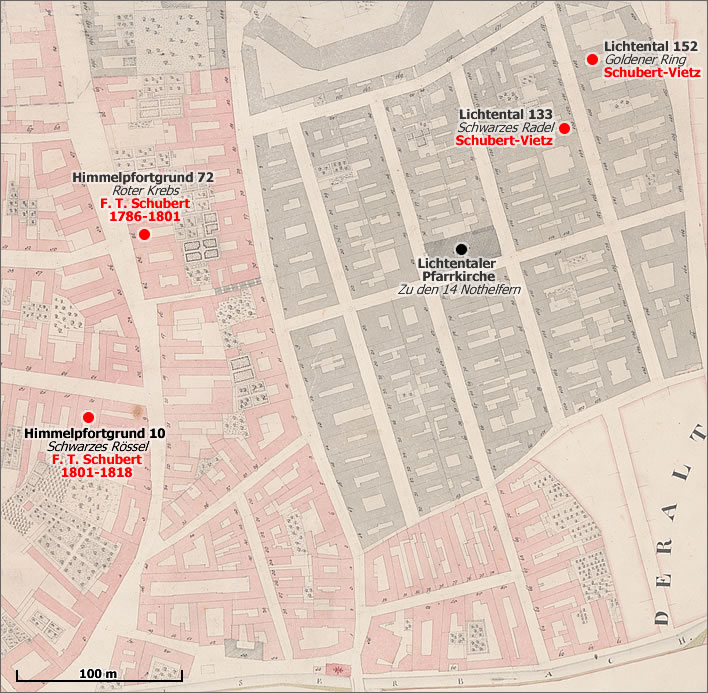
Residences of the Schubert family 1785~1820. Image: Stadtplan, Anton Behsel (1820-1825), Thury, Lichtenthal 1821. ©ViennaGIS/FoS.

Photograph of Himmelpfortgrund 72, the location of the first Schubert school. Date unknown.
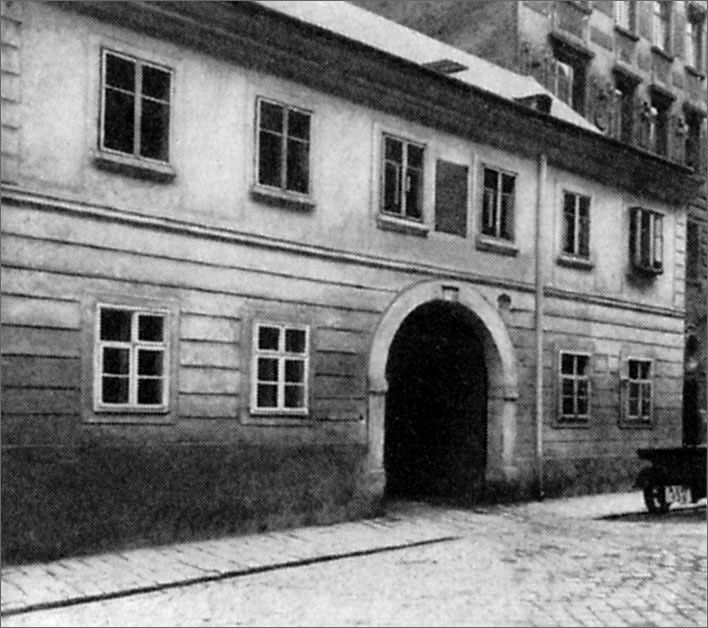
Photograph of Himmelpfortgrund 10 (Säulengasse 3), the location of the second Schubert school. Photographer Martin Gerbach, date unknown.
There were also two crucial moments in the life of Karl, Magdalena and their family. The first of these occurs after years of liaison between the pair, when Karl's wife dies in 1792 and they are finally free to marry.
The second crucial moment comes in 1804 and 1805, when Karl dies and his widow Magdalena moves into Himmelpfortgrund 10 with Franz Theodor and her sister Elisabeth. Magdalena lost a husband but gained a community that included her younger sister. The change must have been particularly significant for their only surviving daughter, Maria Magdalena, who now, as an eight-year-old, came out of Leopoldstadt and into the daily ambit of her cousins, particularly the same-aged cousin Franz Peter.
Babies
Karl and Magdalena had even less luck than Franz Theodor and Elisabeth in producing children who survived infancy. Out of eight children, only one, Maria Magdalena, known as 'Lenchen' to family and friends, reached adulthood (she lived to be 61). Possibly because of her survival when so many of her siblings died she seems to have acquired a special place in the extended Schubert family. She was almost the same age as Franz Peter, too.
Franz Theodor and Elisabeth did better at babymaking, producing nearly twice as many babies (15 in total), five of whom would survive into adulthood.
The five years between 1788 and 1793 were hard ones for Franz Theodor and Elisabeth. After the birth of Ignaz in 1785, every baby they produced until Ferdinand came along in 1794 died. Similarly the twelve years between Karl and Magdalena's marriage in 1792 and Karl's death in 1804 were punctuated with infant deaths.
Franz Peter, growing up
Our abstract, panoptic view of the two families disguises an important fact: Franz Peter, though in our counting the thirteenth child in the family, would perceive a very different family than we do. From his point of view he lived in a family of three older brothers (the oldest much older than the other two), a young sister, Maria Theresia, and, from seven onwards, his cousin Magdalena ('Lenchen').
Between approximately age eleven and sixteen, during term times Franz Peter boarded in the Stadtkonvikt and attended the Academic Gymnasium (1808-1813), which would have added a metropolitan dimension to his life. After completing his secondary education, he returned to Himmelpfortgrund and absolved a year at the Normalschule in order to obtain his teaching diploma. He finally left the family school around 1818, but returned to the school in Rossau on a number of occasions.
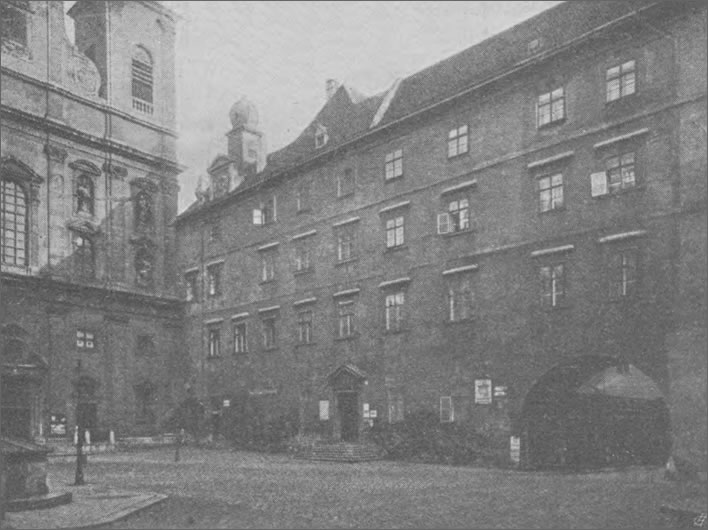
A photograph of the building which housed the Stadkonvikt, where Franz Peter Schubert boarded between 1809 and 1813. Part of the front of the Jesuitenkirche can be seen on the left. Photographer Martin Gerbach, date unknown.

The frontage of the Jesuitenkirche. Part of the Stadtkonvikt can be seen on the right of the image and part of the Aula of the University of Vienna on the left. Date and artist unknown.
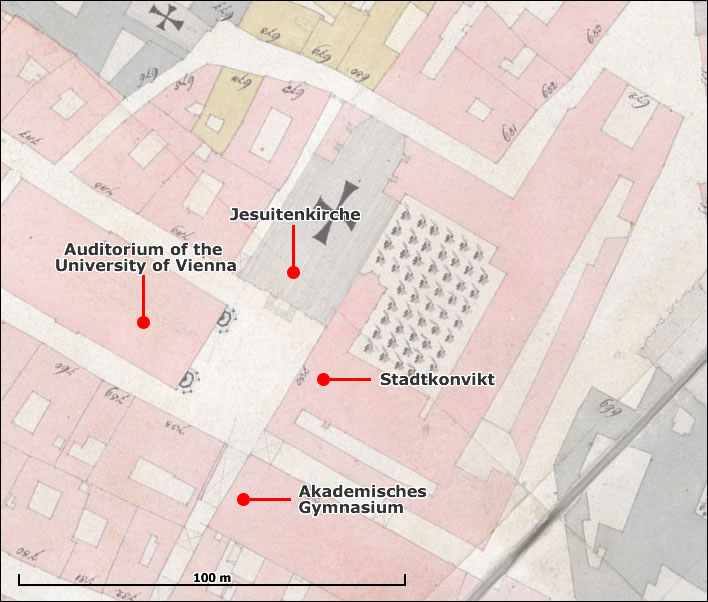
The Stadtkonvikt, the Jesuitenkirche, the Akademisches Gymnasium and the Aula of the University of Vienna. Image: Stadtplan, Anton Behsel (1820-1825), Innere Stadt 1824. ©ViennaGIS/FoS.
0 Comments UTC Loaded:
Input rules for comments: No HTML, no images. Comments can be nested to a depth of eight. Surround a long quotation with curly braces: {blockquote}. Well-formed URLs will be rendered as links automatically. Do not click on links unless you are confident that they are safe. You have been warned!